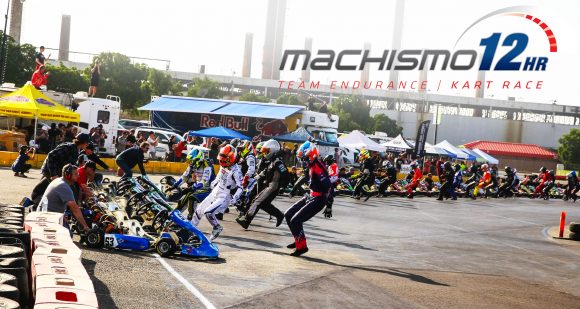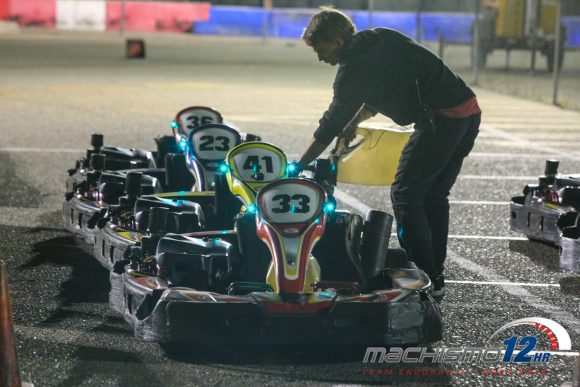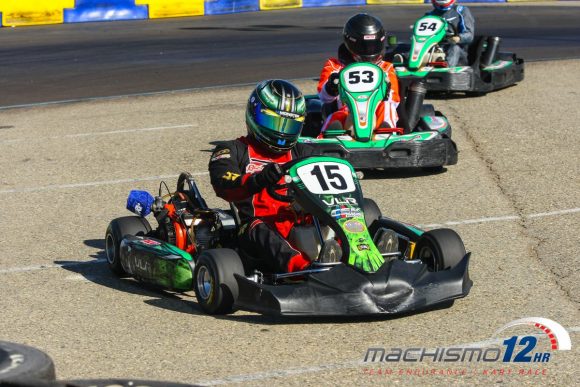
The Machismo 12 Hour is now just 1 week away, and today we’ll take a closer look at the difference in karts that the drivers will be using across all three classes. CalSpeed Karting’s standard sport kart will be used for both arrive and drive classes, while both kart owners and our Event Partners: Josh Huff Motorsports, Troy Adams Coaching, and 2Wild Karting supply the rides for teams in the Pro Class. There will be 40+ teams on course for the 2018 Machismo; now let’s take a look at what they’ll be driving…

Sport (S2) VS Super Sport (S1)
Sport
- Designated by Orange lights and Orange tape on front bumper and Weight Tube
- Marked as S2 on live timing; 17 total teams
- Teams ballast by average team weight; can sometimes put up fastest sport kart times
- Keep same kart all race; start with full fuel and get refueled as needed
- Minimum and Maximum drive time requirements for each driver
- Required to run 36 ‘stints’; either via driver changes or ‘double stints’
Super Sport
- Designated by Green Lights on fairing
- Marked as S1 on live timing; 13 total teams
- Teams ballast by individual driver weight; driver changes take a bit more choreography
- Get a new kart for every fuel stop; most likely 6+ karts used per team
- No drive time requirements
- Required to run 18 ‘stints’; either via driver changes or ‘double stints’
The kart itself is the same between both classes and is also the same ride used at all of CalSpeed’s arrive and drive events: a Sodi GT2 with a Honda GX270 engine, putting out 11ish horsepower, with Decuzzi tires all the way around. The compounds are different front to rear however; a softer compound adorns the front tires than the rear, which is in place to help the balance of these karts since they are so stiff, and heavy. How heavy? Over 325lbs before the driver gets in…
One of the biggest differences between the two classes is the ‘experience cap’ for drivers in the S2 category; essentially restricting it to drivers with less experience and/or regular drivers at CalSpeed that are not regular A-Main racers in the Super Series. Further, the S2 category employs an ‘Average Team Weight’ rule, whereas S1 sees every driver ballasted up to 200lbs. So while both classes utilize the same piece of machinery, they are not necessarily equal across the board; in fact, we sometimes see lighter S2 class drivers compete for fastest laps between the two categories.

Pro Class (P1)
- Designated by White Lights on fairing
- Marked as P1 on live timing; 11 total teams
- Teams ballast by average team weight
- Keep same kart all race; open qualifying fuel level – start with remaining fuel for race
- Minimum drive time requirements for each driver; no max
- Required to change oil once, and run both compounds of tires (must start on Prime)
Unlike the two sport kart classes, the Pro Class will be astride the VLR 206 package, set up in the Spec Configuration, similar to what has been run at Tri-C Karters club races over the past couple of seasons. But what is so different about these to vehicles? Well, for starters this is a competition karting chassis that is purpose-built for the 206 class; the biggest difference being it is a lot more flexible than the stiffer arrive and drive karts. This, of course, makes it much, much lighter, and even though the 206 only produces less power than the larger Honda engine on the sport karts, it is much kinder to the scales at only about 155lbs. Combining the more favorable power-to-weight ratio, plus overall higher grip and maneuverability, and we see lap times 7+ seconds a lap quicker than either sport kart category. Further, teams have the ability to tune -or adjust- their kart to their own liking, including changing gear ratios to fit their specific needs. That said, each kart is still in its ‘Spec’ configuration; meaning that the number of things to adjust are not completely open, and must stay within the Spec package rules. But what is ‘Spec’? For this kart, the seat, wheels, and axle types are specified, as well as the front spindle adjusters -called pills- needing to be the stock ones that allow only a caster adjustment on top. And while the rear sprocket is open, the front drive gear is spec’d at 16; so if there are any variances in gear ratios between the teams, it will happen at the axle. Aside from that, you’ll see teams vary in their approach to front and rear width, ride height, whether or not to apply seat struts, ballast placement, and tire pressures. And speaking of tires, the 2018 edition of the Machismo sees the ‘Option’ tire return to the Pro Class, utilizing the Bridgestone YLC as the softer -or Option- compound, and the Maxxis SLH for the standard, harder ‘Prime’ tire.





 CalSpeed is permanently closed
CalSpeed is permanently closed See the latest images and videos from CalSpeed Karting events
See the latest images and videos from CalSpeed Karting events